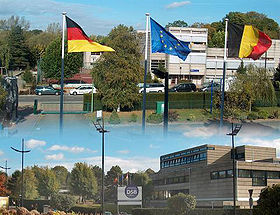International German School Brussels
| International German School Brussels | |
|---|---|

|
|
| type of school | Bilingual preschool , elementary school , secondary school , grammar school , technical college |
| founding | 1803 |
| address |
Lange Eikstraat 71 |
| place | Wezembeek Oppem |
| province | Flemish Brabant Province |
| Country | Belgium |
| Coordinates | 50 ° 51 '9 " N , 4 ° 29' 32" E |
| carrier | German School Association Brussels (asbl) |
| student | about 650 |
| management | Bettina Biste |
| Website | www.idsb.eu |
The International German School Brussels (abbreviation iDSB ) is the German school abroad in Brussels . It was launched in 1803 (before the founding of Belgium in 1830).
Around 600 students study on a campus in the Brussels suburb of Wezembeek-Oppem . A team of around 90 teachers, educators and administrative staff works at the iDSB and is supported by the psychological-pedagogical service. The German School Association Brussels vzw is responsible for the private school and the affiliated bilingual pre-school.
Educational offer
The educational offer includes a bilingual pre-school, a primary school, a secondary school, a secondary school and a technical college as well as a grammar school. In 2003, the iDSB was the first German school abroad to set up a technical college for economics and administration, which was expanded to include the field of social affairs from the 2014/2015 school year. All German school-leaving qualifications up to the Abitur and the German international Abitur are awarded. All certificates and degrees from the International German School in Brussels are recognized by the Conference of Ministers of Education and Cultural Affairs and are equivalent to domestic certificates.
In the bilingual pre-school, children from the age of three acquire knowledge and skills at an early age that will enable them to make the transition to primary school. In mixed-age groups, a bilingual team of educators looks after the little ones in German-English or German-French. Bilingual preschool and elementary school are pedagogically based on the Thuringian education plan for children up to ten years of age, so that a smooth transition to high school is guaranteed.
The main language of instruction is German. Foreign language classes include English, French, Spanish, Dutch and Latin. In the middle and upper grades, subject subjects are partly taught bilingually (German-English).
School life
There are an average of 20 students in the classes. In addition to the classrooms, large playgrounds, sports halls, libraries, the school canteen and the bistro are part of the school's infrastructure with all-day activities. Smartboards and computers are used in lessons as well as in everyday school life from elementary school. There are various additional offers, lunch breaks (MAGs) and guided leisure activities. Job-oriented internships, the annual job exchange, excursions and study trips and visits to extracurricular partners in the classroom provide an insight into other worlds of life. All-day care has been continuously expanded in recent years. A broad DaZ / DaF offer (German as a second or foreign language) enables non-German students to integrate quickly.
history
- 1803: foundation
- 1860: more than 300 students
- 1879: Closure due to discontinuation of city subsidies
- 1890: Preparations for re-establishment
- 1892: Grand opening
- 1910: Visit of the German Empress
- 1918: final school leaving examination
- 1929: School operations resume
- 1944: The last certificates are issued, then the school is closed
- 1952: The school is re-established and school operations begin
- 1969: new building; 1970 Relocation to the new building at Lange Eikstraat 71 in Wezembeek-Oppem
- 2002: New school branch: the technical college
- 2005: Renaming to International German School Brussels
- 2005: Start of the bilingual kindergarten
- 2005: Start of bilingual history and physics lessons in grammar school
- 2007: Spatial expansion of the school by setting up pavilions
- 2008: Equipping the school with smartboards
- 2011: First DIAP exam
Awards
On 18 April 2008, the IDSB has been awarded the seal of approval of BLI awarded (federal / state inspection). The school achieved a score of 3.26 (on a scale from 4 = good to 1 = bad) on this test. The iDSB was one of the first German schools abroad that had to face significantly higher requirements in 2014 in the second round of the federal-state inspection - BLI 2.0 - compared to the first cycle six years ago. The success was summed up by one of the inspectors with "The school (over) fulfilled the requirements for the award of the seal of approval 'Excellent German School Abroad' in all areas."
With the project “Symposion 2006” the student competition of the DIHK “Students build bridges worldwide” could be won. The prize money of € 40,000 was mainly used for teaching materials for the natural sciences.
The school building complex
The current main building of the school was designed in 1967 by the German architect Karl Otto on behalf of the Berlin Senate. The buildings, inaugurated in 1970, consist of standardized construction elements, the "Brockhouse system", which enabled many possible variations in building construction.
The outbuilding on the opposite side of the street is reserved for the lower age group and is connected to the main building by a zebra crossing, which is supervised by high school students.
A new school building is being planned. Completion is planned for 2022–2023.